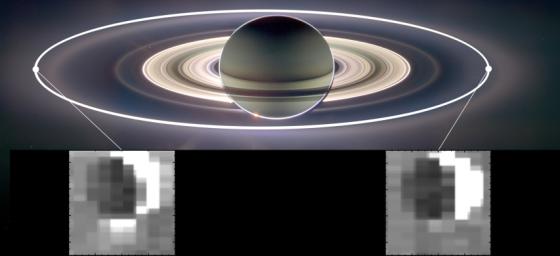Squeezing and Releasing Enceladus
Caption:
This set of images from NASA's Cassini mission shows how the gravitational pull of Saturn affects the amount of spray coming from jets at the active moon Enceladus. Enceladus has the most spray when it is farthest away from Saturn in its orbit (inset image on the left) and the least spray when it is closest to Saturn (inset image on the right).
Water ice and organic particles gush out of fissures known as "tiger stripes" at Enceladus' south pole. Scientists think the fissures are squeezed shut when the moon is feeling the greatest force of Saturn's gravity. They theorize the reduction of that gravity allows the fissures to open and release the spray. Enceladus' orbit is slightly closer to Saturn on one side than the other. A simplified version of that orbit is shown as a white oval.
Scientists correlate the brightness of the Enceladus plume to the amount of solid material being ejected because the fine grains of water ice in the plume are very bright when lit from behind. Between the dimmest and brightest images, they detected a change of about three to four times in brightness, approximately the same as moving from a dim hallway to a brightly lit office.
This analysis is the first clear finding that shows the jets at Enceladus vary in a predictable manner. The background image is a mosaic made from data obtained by Cassini's imaging science subsystem in 2006. The inset image on the left was obtained on Oct. 1, 2011. The inset image on the right was obtained on Jan. 30, 2011.
A related image,
PIA17039
, shows just the Enceladus images. The Saturn system mosaic was created from data obtained by Cassini's imaging cameras in 2006.
Background Info:
The Cassini-Huygens mission is a cooperative project of NASA, the European Space Agency and the Italian Space Agency. NASA's Jet Propulsion Laboratory, a division of the California Institute of Technology in Pasadena, manages the mission for NASA's Science Mission Directorate, Washington, DC. The Cassini orbiter was designed, developed and assembled at JPL. The visual and infrared mapping spectrometer was built by JPL, with a major contribution by the Italian Space Agency. The visual and infrared mapping spectrometer science team is based at the University of Arizona, Tucson.
For more information about the Cassini-Huygens mission, visit
http://www.nasa.gov/cassini
and
http://saturn.jpl.nasa.gov/
.
Cataloging Keywords:
| Name |
Value |
Additional Values |
| Target |
Enceladus |
Saturn |
| System |
Saturn |
|
| Target Type |
Satellite |
Planet |
| Mission |
Cassini-Huygens |
|
| Instrument Host |
Cassini Orbiter |
|
| Host Type |
Orbiter |
|
| Instrument |
Visual and Infrared Mapping Spectrometer (VIMS) |
|
| Detector |
|
|
| Extra Keywords |
Color, Infrared, Plume, Water |
| Acquisition Date |
|
| Release Date |
2013-07-31 |
| Date in Caption |
2011-01-30 |
2011-10-01 |
| Image Credit |
NASA/JPL-Caltech/University of Arizona/Cornell/SSI |
| Source |
photojournal.jpl.nasa.gov/catalog/PIA17040 |
| Identifier |
PIA17040 |

 Planetary Data System
Planetary Data System
